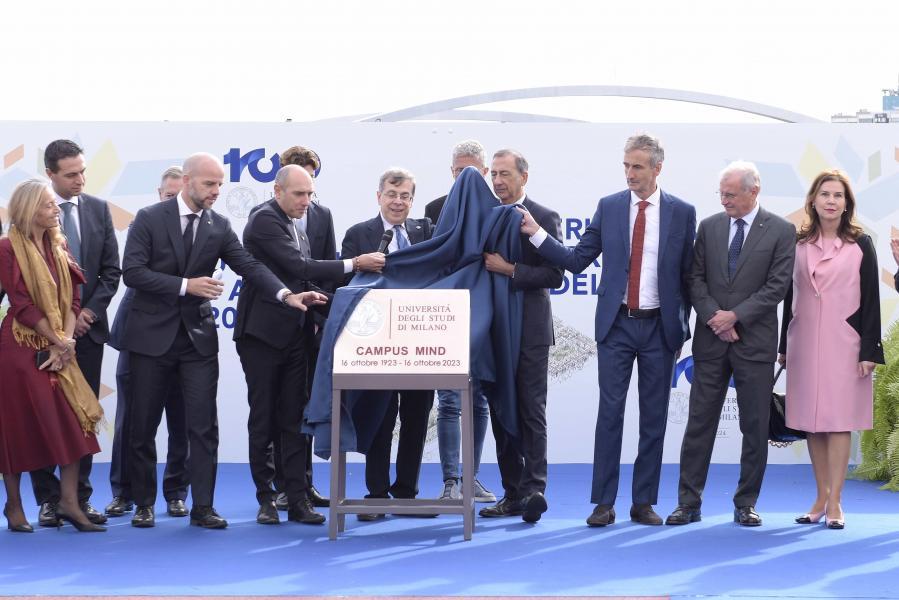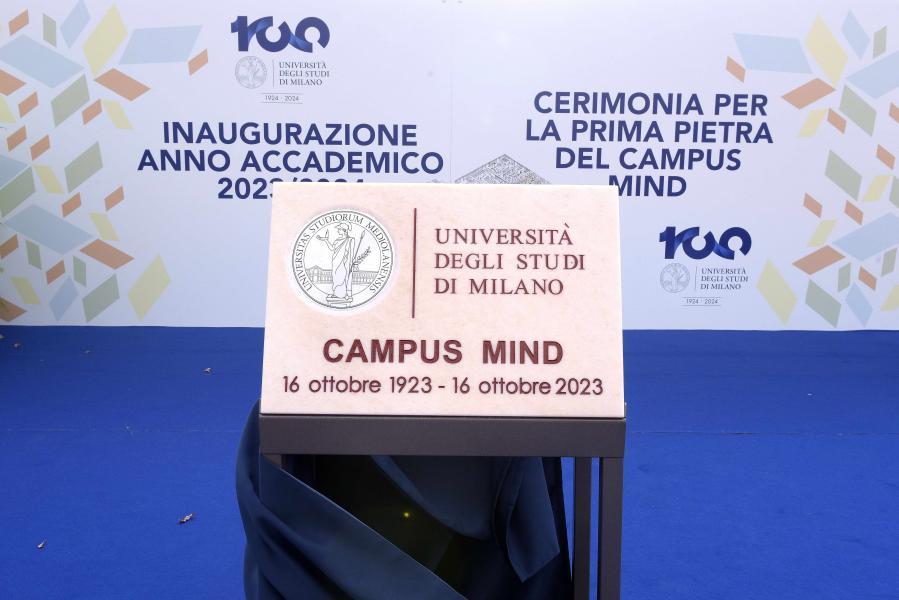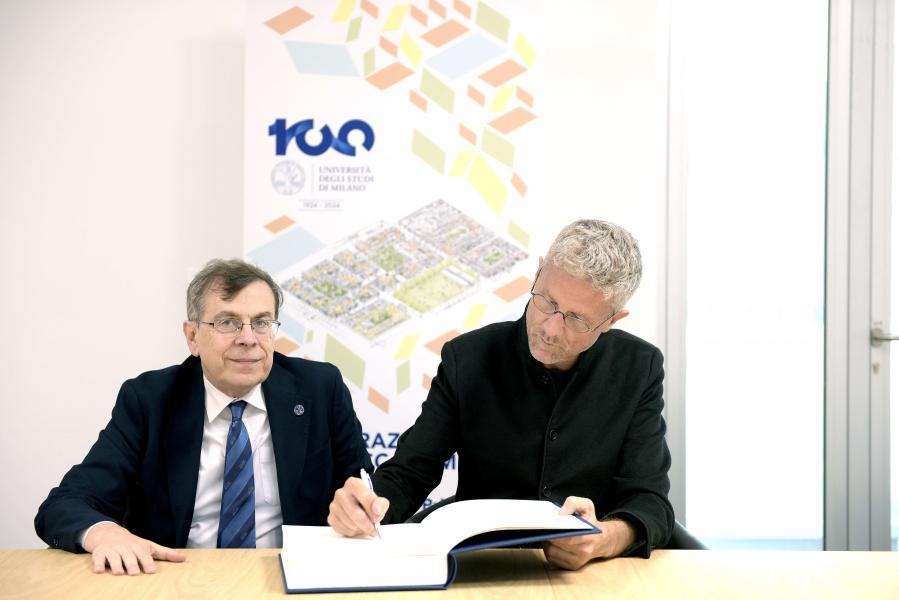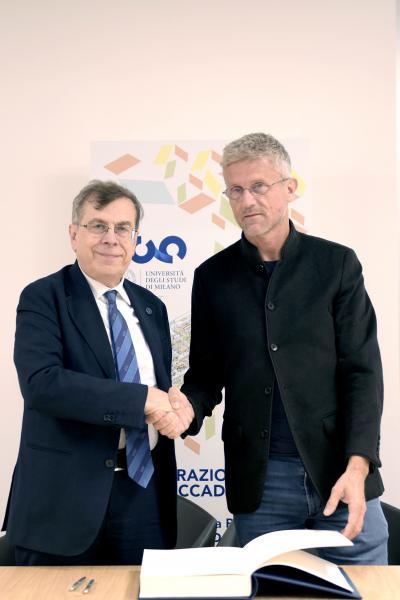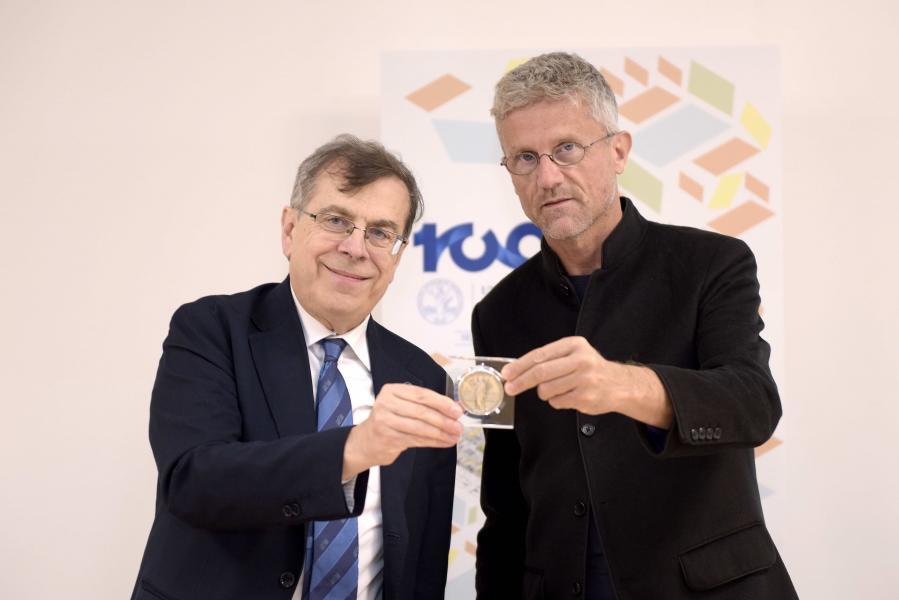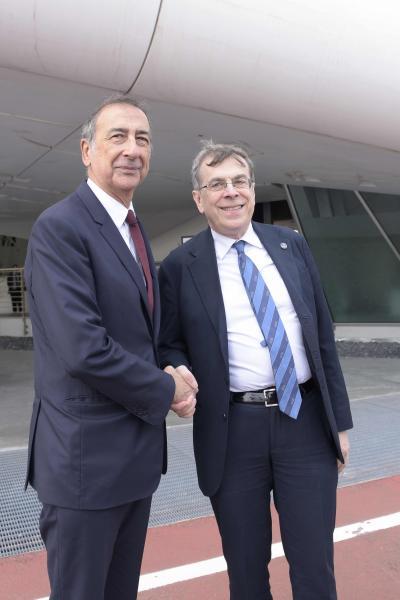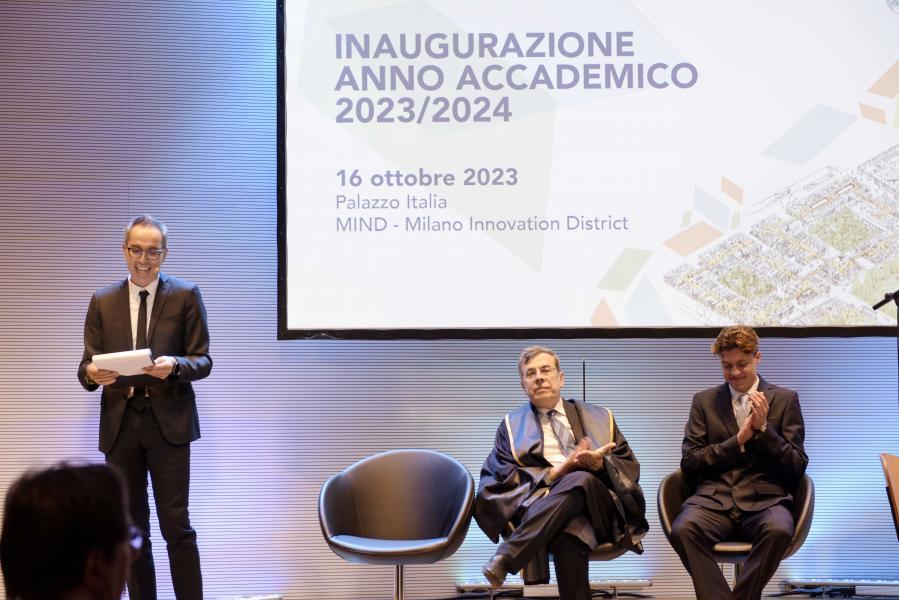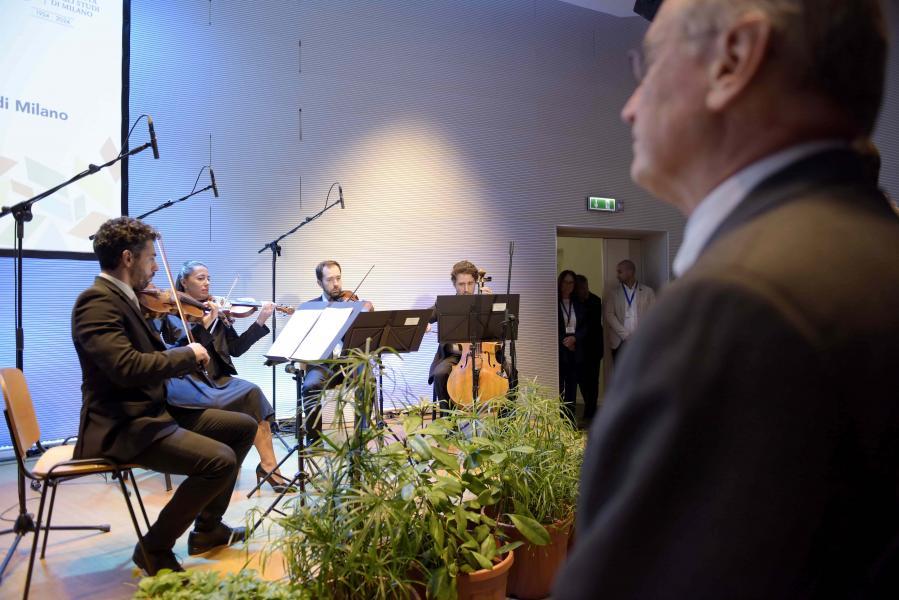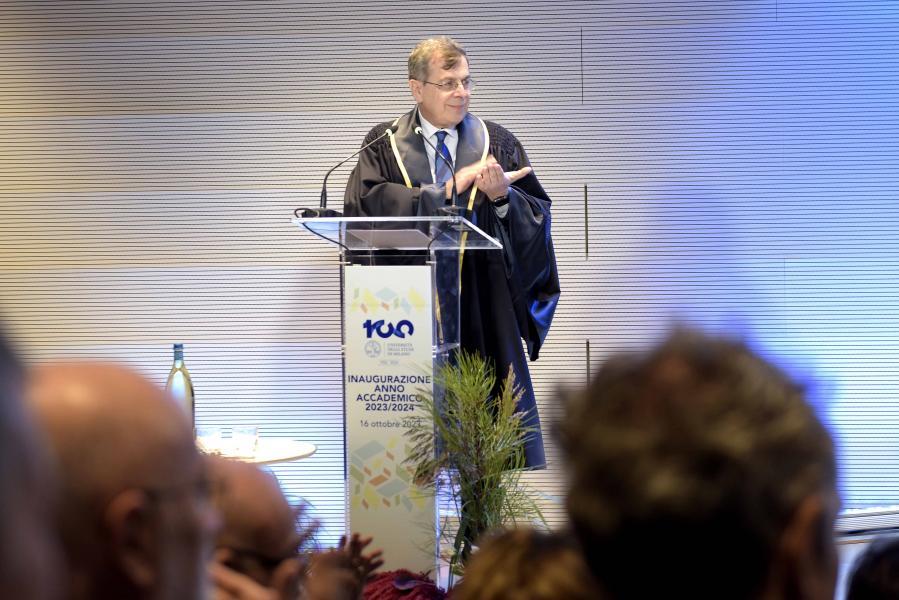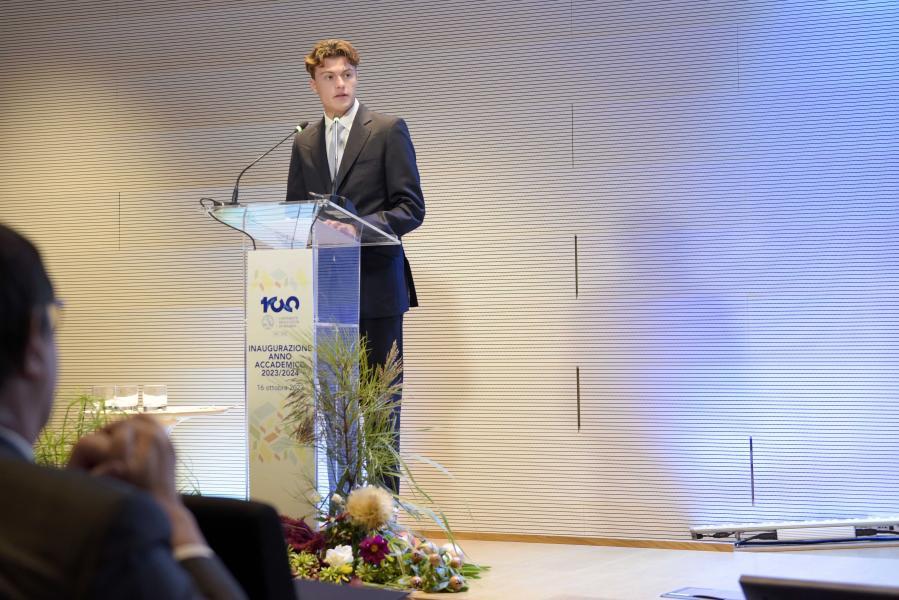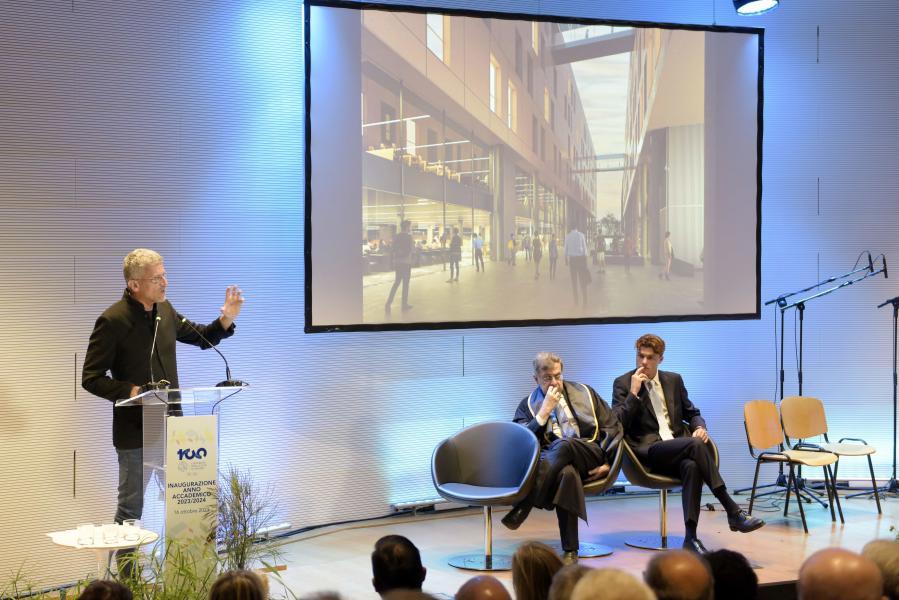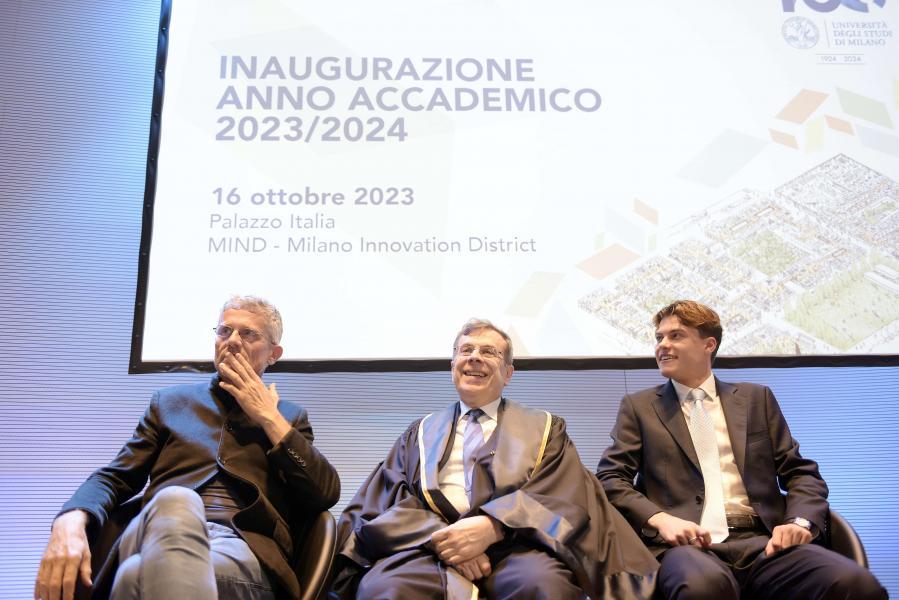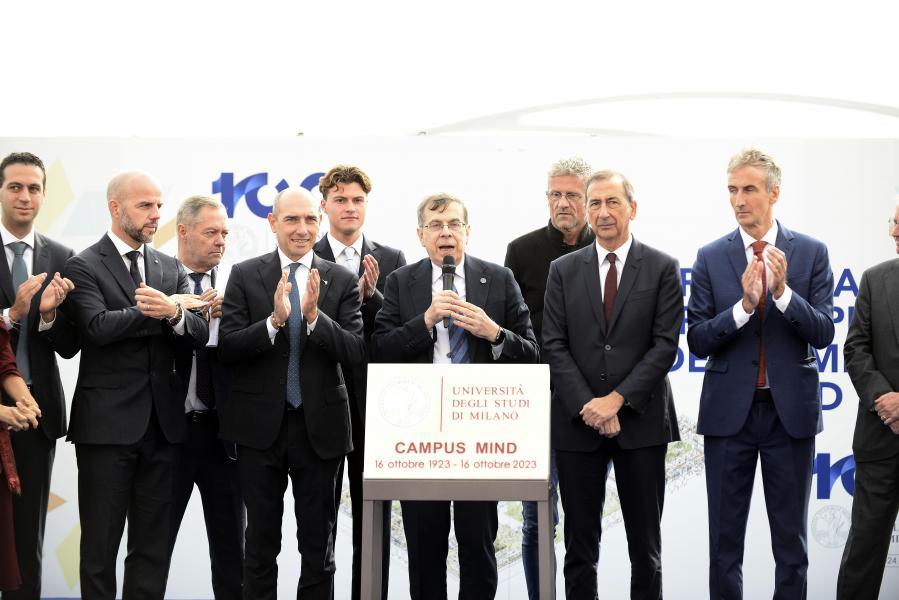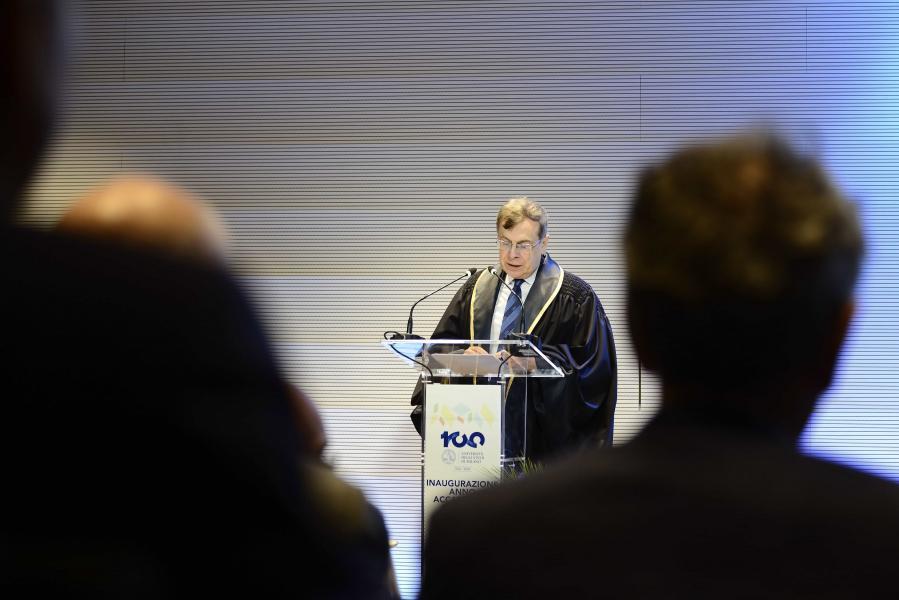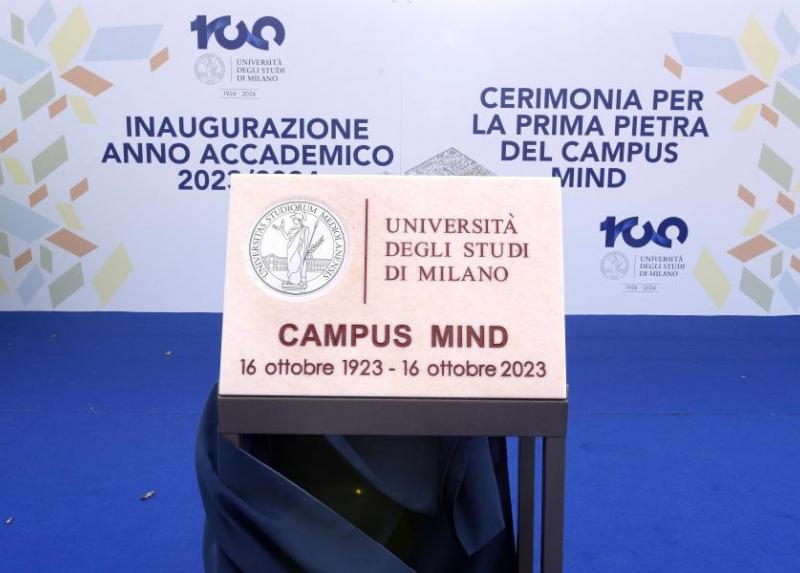
Celebrating the inauguration of the academic year 2023-2024 of the University of Milan - Photo by Paolo Poce.
Palpable emotion run through the air during the inauguration ceremony of the new academic year of the University of Milan, in the Auditorium of Palazzo Italia. Right before the ceremony, the first stone of the future campus, a slab of marble from the Candoglia quarry, had been unveiled in front of a prestigious audience. This included, among others: Elio Franzini, Rector of the University of Milan; Mariapia Abbracchio, Deputy Vice-Rector; Alessandro Morelli, Undersecretary to the Presidency of the Council of Ministers; Cristina Rossello, Councillor of the Minister of University and Research; Alessandro Fermi, Lombardy’s Regional Councillor for University, Research and Innovation; Milan’s Prefect Renato Saccone; Milan’s Mayor Giuseppe Sala; Rho’s Mayor Andrea Orlandi; Monseigneur Luigi Bressan; Gianmario Verona, President of Human Technopole; Andrea Ruckstuhl, CEO of Lendlease Europe; Igor De Biasio, CEO of Arexpo S.p.A.; Carlo Ratti, Director of the MIT Senseable City Lab and architectural mastermind of the new campus in MIND; Elia Montani, President of the Student Council of the University of Milan.
The leitmotiv of the event was the value of symbols, which were carefully selected to identify a transformation process aimed at strengthening the bond between the University of Milan and its history, its memory and its deepest essence. The Candoglia marble chosen for the first stone of the new campus in MIND, which was enthusiastically donated by the Veneranda Fabbrica, is not only a reference to the constant dialogue between the University and the city of Milan – as Milan’s Cathedral, the Duomo, is cladded in Candoglia marble – but also represents a continuity with the University’s origins. As a matter of fact, Candoglia marble had already been used for the first stone of the “Città degli Studi” (literally, a city of studies), for which construction works had started in 1915 in the area formerly known as Cascine Doppie, on the same site where, after eight years of activism by Luigi Mangiagalli, the University of Milan would see the light of day. Now, despite the upcoming relocation of almost all its scientific programmes to MIND, the University has decided not to abandon Città Studi, but to use this area to host a new humanities campus; the project has already started, thus confirming that tertiary education remains the future of Città Studi. The peak of the symbolism running throughout this historic event is the date: the founding decree of the University of Milan dates back to 16 October 1923, exactly 100 years before today’s inauguration ceremony. Both dates have been engraved on the Candoglia marble slab, which will become an iconic element of the new campus.
On its 100th anniversary, after a long journey, the University of Milan finally arrived in MIND, soon-to-be home of a new science campus which is meant to launch the University into the future. And yet, this innovative project is still part of a multi-campus development strategy which remains, in itself, a tribute to the history of the University of Milan, respectful of its multi-disciplinary focus, and of the social and cultural value of its existing infrastructures.
This strategy for the future – not only envisaged, but also tangibly set in motion – is Rector Franzini’s true legacy. Consequently, it was also thoroughly analysed in the speech he made at the ceremony, which happened to be his last inauguration speech as Rector of the University.
All Rectors of the University of Milan – starting from the first, Luigi Mangiagalli – have been confronted with the problem of finding new spaces, stated Franzini. “For anyone who has ever been tasked with governing a University, and values common good, as well as the interests of students, research and teaching, building new infrastructures must be a non-negotiable goal”. The project of the new campus in MIND “was born out of the mind of my predecessor Luca Vago, and will go on after my term, with the succeeding Rector, benefiting from the range of possibilities that different views can offer”. However, as Franzini pointed out, “in spite of the names behind the projects, the MIND campus – just like Città Studi or the reconstruction of the Ca’ Granda complex after the bombings – is not only the product of those leading names, but also the result of the actions of thousands women and men, who, no matter their role, contributed to building something.” This reflection prompted the Rector to reiterate his gratitude to “all and everyone (...), each of whom played an essential role for the growth of the University”. He added that he will “miss them forever” and insisted on this “level-playing field” as a “legacy of my years, which I hope can be respected”.
The Rector chose not to focus on the positive data, which indicate that the University is growing, and used a colourful Milanese idiom to say that when leaving a post, it is advisable not to show off one’s achievement. Instead, he briefly listed the unsolved problems of the Italian university system: a lack of resources, too scarce to ensure, first and foremost, the right to education; certain processes that “make the public sector stiff and scared”; the precariousness of research contracts, a topic on which he had quite harsh words: “Uncertainty does not spark, but actually extinguishes ingenuity, and the rights of our researchers, especially our young women in research, must be taken into account.”
As always, students were at the heart of Franzini’s speech. The Rector recalled the urgency to “create a brighter future for them, with more housing and educational opportunities, because, we should not forget this, students are the ones who constantly bring added value to the world and make it alive”. He also quoted Pope John Paul II, reiterating his invitation not to be afraid “first of all, of your own youth”, and Rector Mangiagalli, who, during his first inauguration speech, defined students as bearers of a “strong breath of freedom”, in the framework of a university which, in Franzini’s words, has to remain open to “any encounter and clash of ideas”.
This definition is in line with the idea of University outlined by the Rector in his speech: in a world “devastated by the madness of wars”, Universities have a duty “to build peace through education, dialogue and the sharing of cultures”. Academia should “become more and more open to the world, to diversity and differences (...) because history has shown all the fragility of reason, unilateral truths and closed ideologies, and unveiled realities where freedom and justice are not vested rights, but new horizons to conquer.”
In accordance with the deeply multi-disciplinary identity of the University of Milan, the Rector emphasised that knowledge, in its many fields, “has to be constantly renewed, not to reproduce an abstract eternity, but to build a system of civil and social values. A one-way interpretation destroys knowledge, turns its depth into a void illusion”.
Quite the opposite, the university is “a multiplication of views, a co-mingling of disciplines aimed at keeping their educational value alive”, but also an “endless complexity, with countless forking paths”. This becomes clear when we try to outline a single story of our University, a single genealogy.
At the end of his speech, the Rector once again recalled the Candoglia marble stone: an icon of our history that, along with our history, “will give colour to these places”. If University means “to continuously build an individual and collective dignity” – Franzini concluded – “research, innovation and reflection are the way forward, the tools that we can use to lay a new stone day after day, beyond people, but together with them.”
The President of the Student Council, Elia Montani, delivered quite a strong speech, focusing on the urgent need to rethink our universities. Academia must be able to respond to the “anthropological challenge that we are facing”, to the need to “facilitate the growth of individuals who can navigate the planetary human condition, and to foster an intelligence of complexity”. The upcoming challenges – Montani continued – require a synthesis between training and education and clearly demand “critically conscious individuals, aware of their responsibilities towards the society, curious, open-minded and forward looking”.
In his presentation, Carlo Ratti, Director of the MIT Senseable City Lab and the architectural mastermind of the new campus in MIND, explored the fundamental role played by university campuses in facilitating the maintenance of “weak ties”. A topic studied in 1971 by US sociologist Mark Granovetter, weak ties are interpersonal relationships that, if compared to close relationships, “connect us with a wider and more diversified group of people. By connecting different social circles, weak ties increase our opportunities to come in contact with new ideas and perspectives, challenging our bias and facilitating innovation and its dissemination”.
Ratti made reference to a study conducted by his group at the MIT in Boston, which showed that physical space is of vital importance for the creation of weak ties. They came to this conclusion by analysing communication networks within the University during the pandemic: “Strong ties had become stronger, while weak ties faltered”. Ratti summed this up as follows: “Video calls and social media can help us maintain our strong ties, but it is unlikely that they will help us create new relationships, not to mention that these tools fail to put us in contact with a large number of people that don’t belong to our social circles. “This is precisely the role of a university campus, a role which is becoming more important than ever in today’s fragmented society”.
Potrebbero interessarti anche

